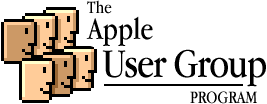One thing that has changed since I started playing with old hardware in the late 90s early 2000s is how much information is now available online due to the effort of archivists who support the Internet Archive’s and Google’s efforts to scan old books, magazines, CD-ROMs and DVDs.
Often when I can’t find details through internet searches I’m able to find what I need by searching/browsing scans of these archived sources. This page contains links to some of the more useful information I’ve found, and information I’ve extracted from CD-ROMs and DVDs and posted on my own site.
The focus of this page is the sources of documentation and other information sources for pre-2000s Macintosh Systems that I’ve written about or referenced on my site.
Published by Apple
Books, binders, newsletters, bulletins and CD-ROMs published by Apple Computer for the various user groups (Logos taken from Apple’s Groups and Interests site: 1997-07-15)
For Apple Computer Users and User Groups
User manuals for early systems:
- 128k, 512k, Plus, SE, SE/30, Classic, Color Classic,
- LC III, LC 475, Performa 500 Series, LC 550, LC 575, LC 580, Performa 600 Series, LC 630, LC 630 DOS, Performa 640 DOS,
- PowerBook: 145, 160 and 180, 165c, 270c, Duo Dock
- 1990 Apple’s the Macintosh Reference: a “working reference” that provides step-by-step instructions for all the tasks that you are likely to perform with the computer
- 1991 Apple’s Learning Macintosh: Everything you need to know to start using your Macintosh Computer
- 1993 Macintosh User’s guide for desktop Macintosh computers
Special Options and Technical Information: classic, IIfx, LC
Apple Product Catalogs: 1986, Summer 1993, Fall 1993
1985 to Present Apple’s Technical Information Library: although it was primarily created for Technicians, a subset was also made available to the public. I heavily reference these articles in my site, and have created a table that cross references the original TIL/KB IDs with the TA IDs that apple later used.
1991 Apple’s the Macintosh System 7 Networking Reference: is a resource for learning how to use the networking capabilities of your Macintosh computer. Your Macintosh comes with many networking features already built-in, so you can begin to use these features almost immediately. This book shows you how to set up your computer on a network, helps you understand what you can do when connected to a network, and gives you step-by-step instructions on how to use the networking features of your Macintosh.
1994 to 1997 Apple’s Information Alley: a bimonthly (twice a month) electronic newsmagazine targeting Apple computer users to help them get full use of their Apple computers, peripherals, and software. Provides copies of the original versions of TIL articles published during that time (vs. modified versions available later on Apple’s site).
1999 and 2000 Apple’s Software Recovery CDs: The Apple Software Recovery CDs, a four volume set, were designed to provide users with a complete and efficient tool for disaster recovery, software installation, and maintenance. I found these CDs, in addition to Apple’s Developer CDs and Apple’s Restoration CDs, to be extremely useful for setting up my 68k Macintosh Systems and you will see them referenced in many of my guides.
For Application Developers
1984 to 1995 Inside Macintosh (original and new): these books provided guidance and examples for application developers about the features, routines, and services available in the Macintosh Operating System for interacting with and managing Memory, Files, Sound, Toolbox etc.
1985 to Present Apple’s Technical Q&As and Technical Notes: provides sample code, and answers to common questions for application developers with references to other Apple documentation such as inside Macintosh.
1985 to 2008 Apple’s Developer Newsletters: published initially as Outside Macintosh, then renamed Outside Apple, then renamed to Apple Direct, then Apple Directions and finally to Apple Developer News, these Newsletters were targeted towards Apple’s developer community, providing articles written by Apple employees, with regular columns from the Software Product Management, Market Intelligence, and International groups. The later news letters provided reviews and descriptions of the contents Apple’s Developer Series CD-ROMs. Those CDs include electronic copies of the the Developer newsletters, Develop Journals (and sample code), and Inside Apple (original and new).
1986 to ? The APDAlog: Apple Programmer’s and Developer’ Association Newsletter / Information Catalog
1989 to 2007 Apple’s Developer CD Series: following the release of Apple’s first CD-ROM drive in 1988 (the AppleCD SC), Apple began distributing software updates and technical information about it’s products on CD. In addition to downloading these for my own use, I am including links to online sources to make it easier for others to find these CDs and I’ve included links to the relevant Apple Direct/Directions articles that describe the contents of each CD. I have found these CDs incredibly useful for learning about and setting up these old systems.
1990 to 1997: Apple’s Develop Journal: providing information about new functionality in the Macintosh Operating Systems and Libraries, and sample code for how to develop applications for Apple computers. The sample code is available on Apple’s Developer Series CD-ROMs. Starting in 1998 the develop journal became a section in MacTech.
1996 to 1997: Apple Development Catalogs: The premier source of Apple-labeled tools, books and technical resources for development on all Apple platforms. I found these catalogs to be very useful for finding URLs I could use in the way back machine to find cached versions of Apple’s sites, and to find out what documents were being published at the time the catalog was published
For Technicians and Hardware Developers
1982 to 1992: Apple Service Technical Procedures: From 1982 to present Apple has published a significant amount of documentation for use by the technicians and hardware developers who repaired Apple hardware and/or designed new hardware components in the Apple Service Technical Procedures Binders.
1985 to present Apple’s Technical Information Library: provides articles that describe technical product specifications, product compatibility information, how to setup and interface products, answers to commonly asked questions, clarifications and updates to manuals, descriptions of known problems and workarounds (if they exist). Later renamed to Apple’s Knowledge base, and then Apple Support.
1990 to 1992 Apple Technical Information Source CDs: contain copies of the Technical Information Library in HyperCard format, Developer Notes for many of the Apple Systems and other information resources, installers for Apple System software and peripheral software, updates for third party software, utilities and more.
1990 to 1997 Apple Service Guides: A series of supplemental booklets that help Apple certified technicians troubleshoot and repair Apple products at customer’s sites. The Apple Service Guide series contains information condensed from a number of Apple Service products and sources, it includes only need-to-know information for the experienced technician. These guides to NOT replace the Apple Service Source CD.

1992 to 1997 Apple Service Source CDs: Service Source CDs contain comprehensive troubleshooting and repairing information on Apple products, as well as Apple Authorized Service Provider Program information. They were a primary resource for technicians and administrative personnel about Apple service. These CDs are an extremely useful source of technical details about 80s and 90s Macintosh Systems.
1993 to 1998 AppleFacts: Concise guides to Apple computers, printers, displays, and other Apple products. AppleFacts was a convenient, one-stop reference for basic technical information, such as key product specifications, upgrade paths, and accessories. Also includes information on Apple software and occasionally 3rd party software. Replaced in 1999 by AppleSpec a web based searchable database.
For Apple Computer Resellers and Solution Professionals
1986 to 1991 Apple’s AppleGram bulletins: A bulletin produced by Sales Communications in Apple USA and mailed to registered Professional System Consultants that describe new products, changes to existing products, and articles about the use of Macintosh Computers by various industries.
1987 to 1989 Apple’s Information Exchange: was a collection of marketing program descriptions, tip sheets, Apple event schedules, key Apple contacts, Apple trade-show schedules, and other information. It provided readers with an overview of Apple’s marketing direction, as well as outline specific opportunities that readers could take advantage of to help market their Apple-compatible products.
1989 Apple Partner Info-CD: 2 volume CD set created by Apple Dealers in the Netherlands, available on the Macintosh Garden: Volume I 1989, Volume II 1989-10
1989 to 1994 Apple Reference and Presentations Library (ARPL) CDs: to do, became ARPLE (below)
1990 to 1995: Apple Media Toolkit (AMT) CD: contain printable data sheets, product photography, line art, ad slicks, multimedia files, and more!: Fall 1992 (IA), Spring 1993 (IA), Summer 1993 (IA), Fall 1993 (IA), May 1994 (IA),
1992 to 1995 Apple Computer’s Connectivity Demonstration and Support Network (CDSN) Reference CDs (MG)
1993 to 1998 Apple Service Information Resource (SIR) CDs: The purpose of these CDs was to provide Apple Resellers and other people with a tool which will allow them to support their customers in a more effective way. These CDs do not replace the Apple Technical Guides or CDs but are a good collection of tools which may be needed to diagnose and/or repair a defective Macintosh or other Apple equipment. I have not created a post yet for this, the link is to the Macintosh Repository.
Restoration CD for Market Software: Restoring software can be particularly difficult when third-party applications are bundled with the customers unit at the time of sale. Specifically designed for this situation, the Apple Restoration CDs for Market Software come complete with the correct version of system software and all the original applications that were bundled for specific markets or promotions. Each Restoration CD in this series is sold separately. As of February 1996, the following volumes are offered:
- Volume 1, Restoration CD for Market Software (MAR ’94) Consumer/Performa (600-1432)
- Volume 2, Restoration CD for Market Software (FEB ’94) Education Software for AELC, Back to School & Educator (600-1397) (MG) (MR)
- Volume 3, Restoration CD for Market Software (JUN ’94) Education & Consumer Software. (600-1585) (MG) (MR)
- Volume 4, Restoration CD for Market Software (SEP ’94) Systems Remarketing & Performa 500, 630 Series, and 637 (600-1752)
- Volume 5, Restoration CD for Market Software (JAN ’95) Fall 1994 software for Performa 6100 Series & AELC. (600-1977) (readme)
- Volume 6, Restoration CD for Market Software (MAY ’95) Spring 1995 Performa Software for 5200LC/75 & 640CD DOS (600-2616)
- Volume 7, Restoration CD for Market Software (JAN ’96) Fall 1995 Performa Software for 6205CD, 6214CD & 6216CD (600-3647)
- Volume 8, Restoration CD for Market Software (JAN ’96) Fall 1995 Performa Software for 5215CD, 6200, 6218 & 6220CD (600-3648)
- Volume 9, Restoration CD for Market Software (JAN ’96) Fall 1995 Performa Software for 5200CD & 6230CD. (600-3649)
- Volume 10, Restoration CD for Market Software (JAN ’96) Summer 1995 Education Software for LC580 & LC5200/75 (600-365)
1994 to 1998 Apple Reference, Performance and Learning Expert (ARPLE) CDs: became ASMRL (below)
1995 to 1998 Apple Marketing Toolkit (AMTK) CDs: replaced the Media Toolkit CDs.
1998 to 2000: Apple Sales and Marketing Resource Library (ASMRL/ARL) CDs: starting September 1998, the Apple Reference, Performance, and Learning Expert (ARPLE) and Apple Marketing Toolkit (AMTK) CDs were merged in to a single ASMRL CD. Site: resourcelibrary.apple.com (unfortunately not much was cached)
For Apple Employees
1989 to 1996 Apple Internal Summit, Retreat, Camp, Conference CDs (MG)
1991 to 1995 Apple Internal Site-Licensed Software CDs (MG): This CD-ROM contains Apple Software, Site Licensed Software, and Training & Technical Information.
Apple Software Updates
Starting in 1994 Apple began offering software updates and information about it’s products on the Apple.com website. The internet archive‘s way back machine is a very useful tool in finding information that used to be posed on Apple and other websites from 1996 onward.
- 2002: software updates (what I reference the most)
- 2005: software updates, manuals
- 2013: software updates, manuals
Books
- The internet archives MacBooks collection, specifically books on upgrading old systems with accelerators or other upgrade options:
- Bob Brant’s: Upgrade Your Macintosh and Save a Bundle (1991), Build your own Macintosh and Save a Bundle (1992)
- Bob Vitus’s: Doctor Macintosh (1989, 1992), and other reference books for system software and applications.
- Larry Pina’s: Macintosh Repair and Upgrade Secrets (1990), Macintosh II Repair and Secrets (1991), Dead Mac Scrolls (1992), Mac classic & SE : repair and upgrade secrets (1993)
- Garry Howard’s: The Macintosh Do It Yourself Upgrade Book (1992)
- Gene William’s: Chilton’s guide to Macintosh repair and maintenance (1986)
- Todd Stauffer’s: Using your Mac (1995), Mac Upgrade and Repair Bible (1998)
- And scans of old manuals, to find things such as Macintosh accelerator manuals, or information on other hardware.
- Ted Nelson’s Junk Mail Cartons, contains brochures for a lot of old technology.
Magazines
The internet archive‘s searchable scans of old magazines and newsletters has helped me find information on old hardware and software that existed pre-internet or was produced by a company who’s website was not cached by the way back machine
- ComputerWorld (alternate collection)
- MacFormat (IA, MG)
- MacWorld Magazine (VA), printed versions from 1984 to 2014, only offered online after that.
- MacWorld Annual Index, lists what products were reviewed during the year. Useful for finding things that the text search of the Magazines may have missed.
- MacUser Magazine, (VA) printed version from 1985 to September 1997 when it was merged with MacWorld
- MacUser UK
- MacAddict Magazine, printed version 1996 to 2007 when it was relaunched as MacLife.
- MacAzine Magazine, can’t find much info on this magazine, or online scans.
- MacWeek News Letter
Websites
- 68kMLA: the Macintosh Liberation Army is a very active discussion group for anyone interested in playing around with 68k and PPC Macintosh Systems.
- comp.sys.mac.hardware, a mirror from the 80s and 90s.
- TidBITS: a newsletter started in 1990, I found the site’s built in search did not work very well and I had better luck using a site restricted google search.
- Verycomputers archive of a discussion group from the early 90s
- Vintage Apple scans of books and magazines.





Hi.
I’m doing a clearout, and I have an Apple Service Source CD Jan 1993.
What should I do with it – can the stuff on it be hosted somewhere?
Or is it already, in which case this goes in the bin.
It might already be uploaded, see https://www.savagetaylor.com/2024/03/24/apple-service-source-cds-and-website/
If not, the Macintosh Garden would be a good place to put it.